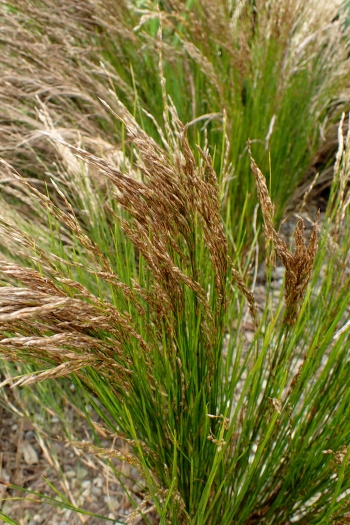Green Grass Reed
(Restio festuciformis)
Green Grass Reed (Restio festuciformis)
/
/

Krzysztof Ziarnek, Kenraiz
CC BY-SA 4.0
Image By:
Krzysztof Ziarnek, Kenraiz
Recorded By:
Copyright:
CC BY-SA 4.0
Copyright Notice:
Photo by: Krzysztof Ziarnek, Kenraiz | License Type: CC BY-SA 4.0 | License URL: https://creativecommons.org/licenses/by/2.0 | Uploader: Kenraiz | Publisher: Wikimedia Commons |

























Estimated Native Range
Summary
Restio festuciformis, commonly known as Green Grass Reed, is an evergreen perennial grass native to the fynbos heathlands and coastal plains of Southwestern South Africa. It typically grows to a height and width of approximately 1 foot (0.3 meters), forming dense tufts of fine, needle-like foliage that give it a grass-like appearance. The plant produces inconspicuous brownish flowers during the spring, which are often overlooked in favor of its fine-textured foliage.
Green Grass Reed is valued for its low-maintenance nature and its ability to thrive in poor, sandy soils, making it an excellent choice for xeriscaping and coastal gardens where water conservation is a priority. It is often used in mass plantings for ground cover, as well as in ornamental grass borders and rock gardens. This species prefers full sun exposure and requires well-drained soils to prevent root rot. While it tolerates low to medium water conditions, it will benefit from occasional watering during prolonged dry spells. Restio festuciformis is generally pest and disease-free but can be sensitive to overly wet conditions. It is not known to be invasive when grown outside its native range, and there are no significant reports of aggressive root systems or other cultivation problems.CC BY-SA 4.0
Green Grass Reed is valued for its low-maintenance nature and its ability to thrive in poor, sandy soils, making it an excellent choice for xeriscaping and coastal gardens where water conservation is a priority. It is often used in mass plantings for ground cover, as well as in ornamental grass borders and rock gardens. This species prefers full sun exposure and requires well-drained soils to prevent root rot. While it tolerates low to medium water conditions, it will benefit from occasional watering during prolonged dry spells. Restio festuciformis is generally pest and disease-free but can be sensitive to overly wet conditions. It is not known to be invasive when grown outside its native range, and there are no significant reports of aggressive root systems or other cultivation problems.CC BY-SA 4.0
Plant Description
- Plant Type: Grass
- Height: 1-1.5 feet
- Width: 0.867-1.3 feet
- Growth Rate: Moderate
- Flower Color: N/A
- Flowering Season: Winter, Spring
- Leaf Retention: Evergreen
Growth Requirements
- Sun: Full Sun
- Water: Low, Medium
- Drainage: Fast
Common Uses
Border Plant, Groundcover, Low Maintenance, Potted Plant, Salt Tolerant
Natural Habitat
Native to the fynbos heathlands and coastal plains of Southwestern South Africa
Other Names
Common Names:
Scientific Names: , Restio festuciformis, Leptocarpus parkeri, Restio ischaemoides,
GBIF Accepted Name: Restio festuciformis Nees ex Mast.